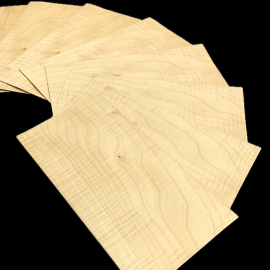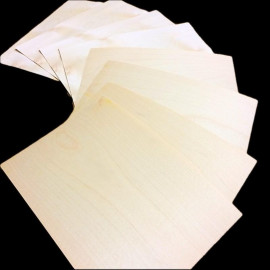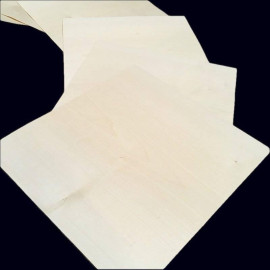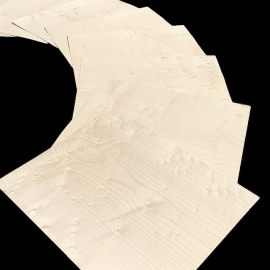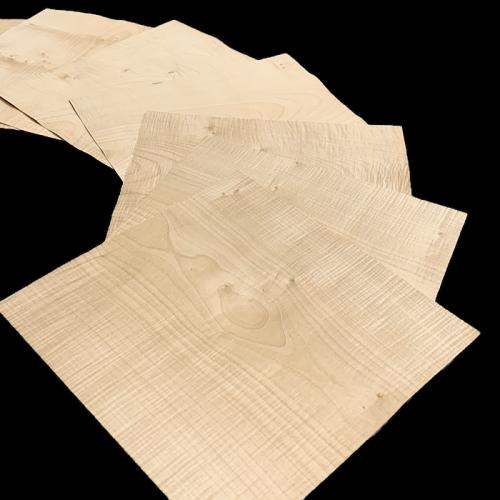
Weathered Figured Sycamore XXL Width Small-size Veneers
Weathered Figured Sycamore XXL Width Small-size Veneers
Genuine wood sliced-veneer sheets.
Selected single veneers, no sequence.
Fix length of 30 cm long.
Width: From 22 to 30 cm, depending on availability.
Thickness: 0.6 mm.
Sold by the sheet.
Caution: carefully read the full description of these veneers.
Weathered Figured Sycamore XXL Width Small-size Veneers
Genuine wood sliced-veneer sheets.
Selected single veneers, no sequence.
Note: Weathered Sycamore is a Sycamore veneer aged to a golden hue. This natural patina highlights the wood's figures and pin-knots, making it ideal for repairing antique furniture while preserving the overall appearance.
Dimensions:
Fix length of 30 cm long.
Width: From 22 to 30 cm, depending on availability.
Thickness: 0.6 mm.
Sold by the sheet.
Measurement scaling:
The width is rounded to the covered centimeter, for example, 15.8 cm, giving 15 cm.
Species:
Common names:
Sycamore, European maple, sycamore maple.
Botanical name:
Acer pseudoplatanus.
Origin:
The sycamore maple is the European maple found throughout Europe, North Africa, and Western Asia. It is one of the most common trees in Europe.
Appearance:
Sycamore is a hardwood called "white" but slightly ivory. Unlike its North American cousin, the sugar maple, it does not have "sugar hair." However, sycamore has small wood-colored pin-knots; these are inevitable, and a sycamore without pin-knots is extremely rare.
This forest species is one of the semi-precious hardwoods, but in its figured form (less than 1% of forest production), it becomes a precious wood.
Sycamore is called "plain" when it is not figured. However, plain sycamore can occasionally have flames and shadow figures, which are very light figures that are not marked enough to be considered figured wood.
Properties:
Weight: 615 to 650 Kg / m3, average weight at 10 - 12% humidity.
Janka hardness: 4680 Newton. For comparison, Oak is 4980 N, and Poplar is 1650 N.
Elasticity: 9.92 GigaPascal, for comparison: Ash 12.31 GPa and Poplar 9.75 GPa.
Uses:
Its natural beauty and strength make it a popular wood for furniture manufacturers, stairs, parquet floors, and paneling.
In instrument making, Luthiers particularly appreciate the veneers of flamed sycamore for their warm sound, especially for making violins, cellos, and double basses.
In decoration: Its light color and fine grain blend perfectly with various interior styles, bringing a touch of elegance and modernity.
Product Description:
Genuine wood-sliced veneer sheets.
These veneers are raw without a finish or any fleece back.
The veneer surface is similar to plane wood. However, it will be preferable to forecast a light sanding after gluing.
The veneers are offered here as wood-sliced sheets of one and unique thickness.
Both faces of these veneers are the same, without fleece back, without glue.
Even if the veneer's sides had been cut relatively straight, it isn't a precise parallel clipping; some veneers may have kept the decreasing shape of the tree, wider at the bottom end and narrower at the top end.
Very occasionally, some veneers' sides have traces of unclipped wane, but our veneers are measured at the narrowest, as explained in the paragraph "Dimensions."
As genuine natural wood, all finishing products are acceptable as long as they are meant for wood use.
The choice of the finished product must be consistent with the final usage realization.
Use of the veneers:
Cutting:
Veneers can be easily cut with a utility knife.
For straight cuts, the best results are obtained with a veneer saw.
Use a fretsaw, scalpel, or veneer knife for curved cuts.
Always allow for a slightly larger veneer sheet than your intended surface. This will allow you to adjust the size after gluing for a clean finish.
A flush trimmer can also be used to trim the veneer after gluing.
When cutting with a utility knife or veneer knife, it is best to cut with the grain of the wood. To check this, run your finger along the edge of the sheet. The direction that feels smoothest is the ideal direction for cutting.
Gluing:
Several types of gluing are possible.
With vinylic glue, the veneer is pressed over its entire surface.
With neoprene glue for all surfaces, especially non-porous surfaces, by applying two coats of glue and marouflage.
With animal glue such as hide, sinew, or bone glue.
With vinyl glue and an iron, apply two thin coats of glue to each piece. This technique should only be used if other gluing techniques are not possible.
Sanding:
Veneers and all our products are genuine wood and can be sanded according to their thickness.
Please do not use a belt sander, regardless of the thickness of the veneer, as this could pierce it.
With a 0.6 mm veneer, lightly sand with 120 grit and then finish with 180 or 240 grit. With an orbital sander, 180 grit is already sufficient for most applications.
Finishing:
All finishing products generally used for wood are suitable for finishing our products. For example, you can use a varnish, wax, paint, or oil.
However, ensure that the product you want to use is compatible with the final use of your creation.
Photos:
To keep the cost of these products as cheap as possible and contrary to other veneers on this website, the pictures of small-size veneers do not represent the available stock.
More information:
Please look at our TUTORIALS; you might find some valuable tips.
Please get in touch with us by email or phone for any additional information.
Data sheet
- Species
- Sycamore
- Thickness group
- Standard
- Width group
- XXL width
- Grade
- Fiddled back
Weathered
You might also like
 English
English





